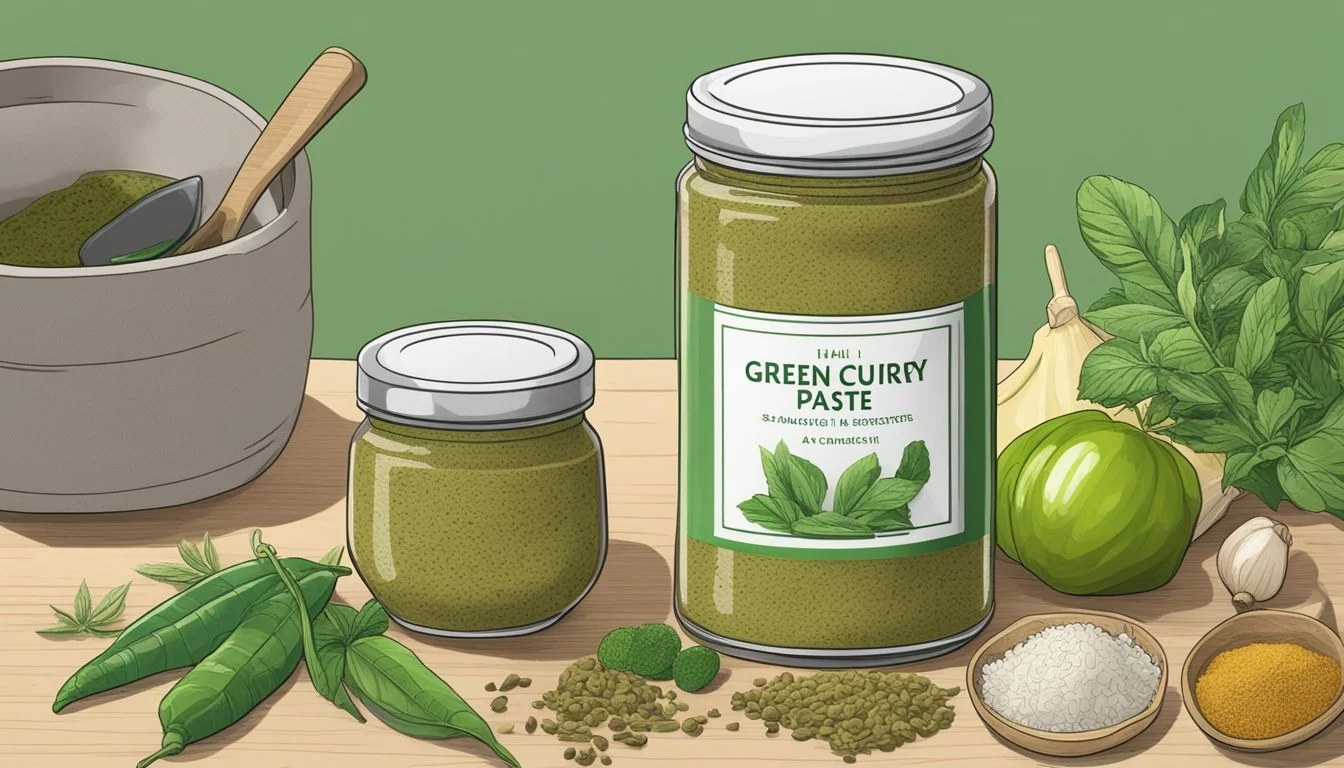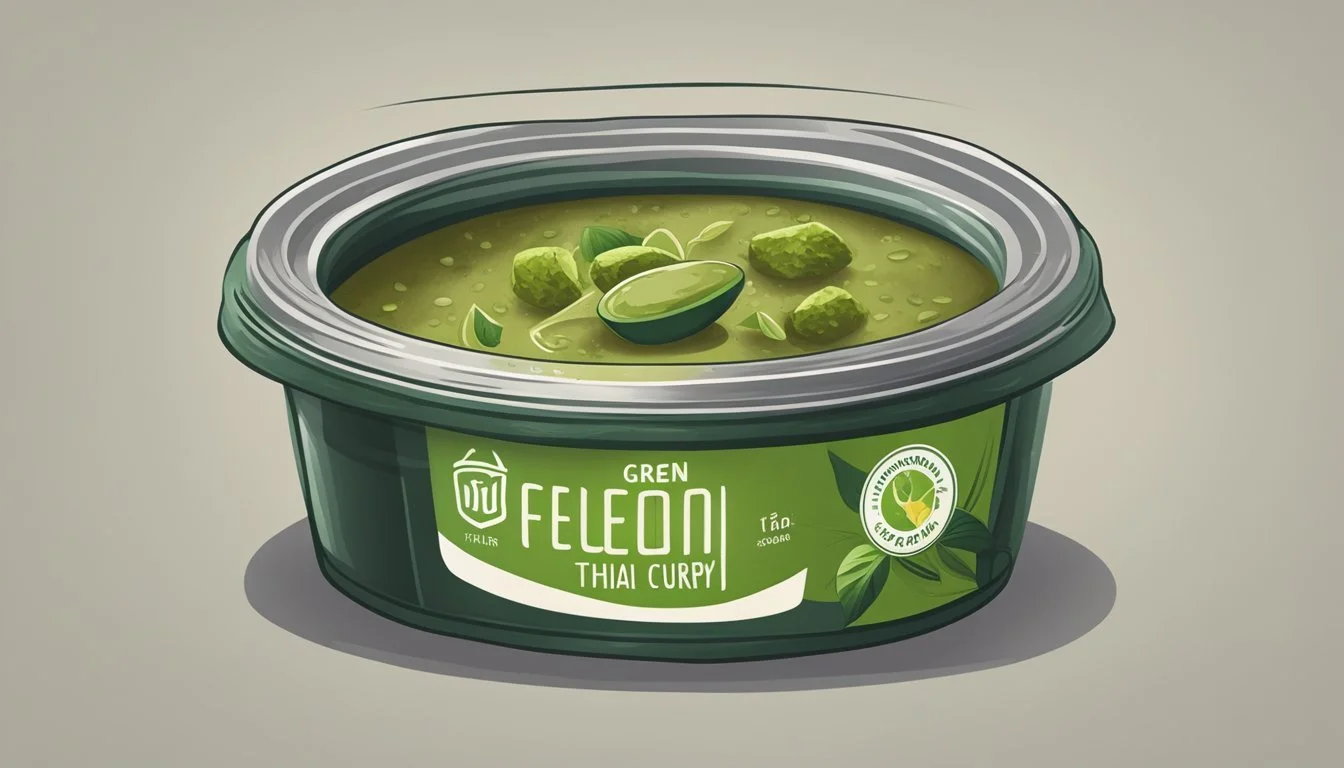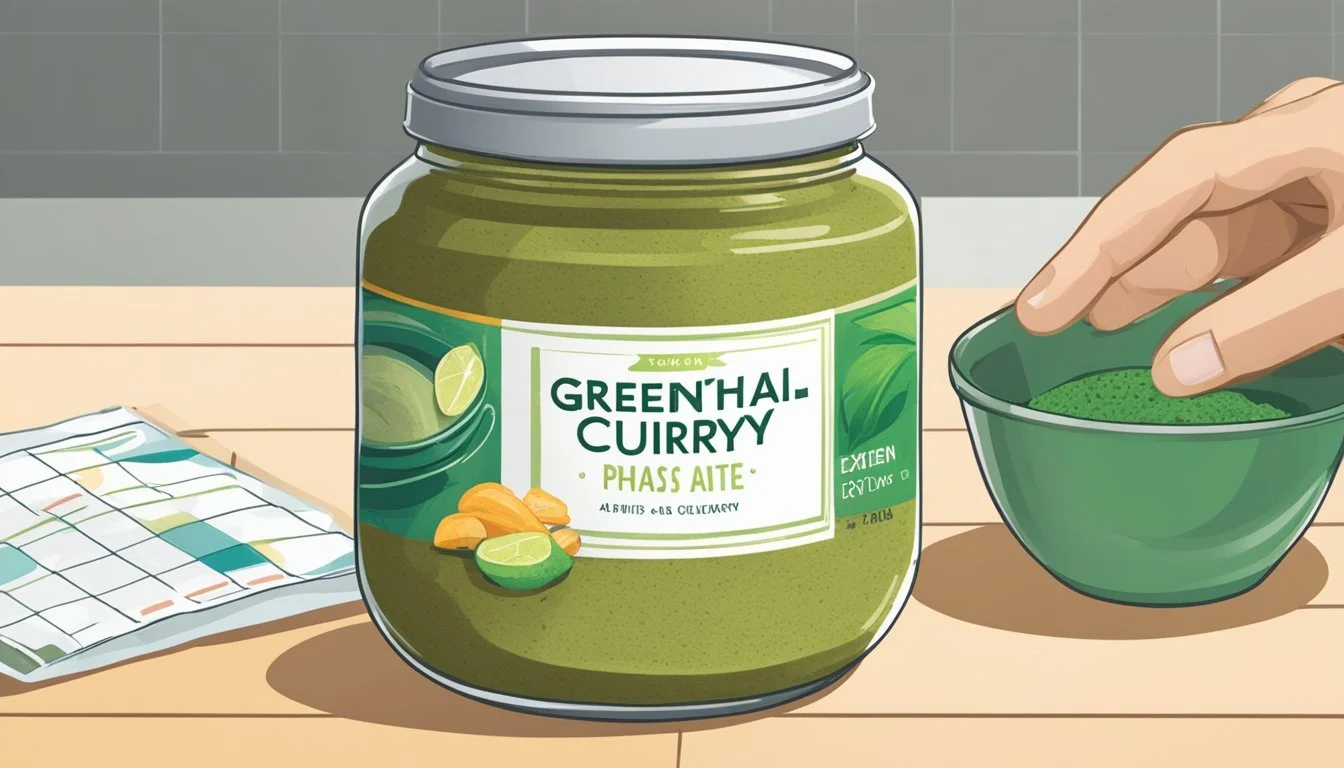Does Green Thai Curry Paste Expire? Shelf Life Insights
Green Thai curry paste, a staple in many kitchens, brings a burst of authentic flavor to various dishes. Yes, green Thai curry paste does expire, especially once opened. It's best used within 2 to 4 weeks when kept in the refrigerator to maintain its freshness and robust taste.
The shelf life of unopened green Thai curry paste extends much longer, often three years or more, provided it’s stored properly in a cool, dry place away from direct sunlight. Even so, it's essential to keep track of the expiry date and storage conditions to retain its quality and safety.
For those who love cooking with green Thai curry paste, understanding its expiry is crucial to ensure each dish tastes as vibrant as intended. Whether you’re a seasoned chef or a home cook, knowing how to store and use curry paste effectively can elevate your culinary creations.
Understanding Curry Pastes
Curry pastes are essential in many cuisines, providing rich, aromatic bases for dishes. Differing types and their ingredients define distinct flavor profiles and culinary uses.
Types and Flavor Profiles
Green Thai curry paste is known for its vibrant, herbal flavor. Made with fresh green chilies, it delivers a spicy kick complemented by ingredients like lemongrass and basil.
Red Thai curry paste has a bold, robust taste. Red chilies give it a deep color and heat, balanced by garlic, ginger, and coriander roots.
Yellow Thai curry paste offers a milder, earthier profile. Its primary flavor comes from turmeric, which provides a warm, slightly bitter taste, often softened with cumin and coriander seeds.
Each paste differs in spice levels and ingredient combinations, making them versatile in various dishes.
Main Ingredients in Thai Curry Paste
Green, red, and yellow Thai curry pastes share some core ingredients, yet vary significantly in others. Common ingredients include:
Garlic
Shallots
Lemongrass
Galangal
Different chilies bring unique flavors and heat levels. Green chilies are used in green curry paste, red chilies in red paste, and yellow chilies along with turmeric in yellow paste.
Other notable ingredients include shrimp paste, kaffir lime leaves, and coriander roots, each adding complexity and depth to the curry pastes’ profiles. The balance of these ingredients is crucial for achieving the authentic taste characteristic of Thai cuisine.
Shelf Life of Green Thai Curry Paste
Green Thai curry paste has a specific shelf life that depends on whether the jar is opened or unopened. Expiration dates, storage conditions, and signs of spoilage are crucial to ensuring food safety.
Expiration Date and Food Safety
The expiration date on green Thai curry paste indicates the manufacturer's suggestion for peak quality. Unopened curry paste can retain its quality for 3 or more years if stored in a cool, dry place.
This date is a guideline, but actual safety depends on storage practices. It's essential to check for any signs of spoilage before use, even if the paste is within the expiration window.
Unopened vs Opened Jars
Unopened jars of green Thai curry paste last significantly longer—up to several years. Proper storage in a pantry or a cabinet ensures the paste remains fresh.
Opened jars, once exposed to air, must be refrigerated immediately. Stored correctly, they maintain peak freshness for 2 to 4 weeks. Over time, the flavors and quality may further deteriorate, even if the paste remains safe for a few more months.
Signs of Spoilage
Checking for spoilage is crucial for food safety. Spoiled curry paste often shows visible mold, a change in color, or an off smell. The texture may also change, becoming less smooth.
If any of these signs are evident, it is best to discard the paste. Even without a bad smell or mold, a significant flavor loss or an odd taste can indicate spoilage.
Proper Storage Techniques
Storing green Thai curry paste properly helps extend its shelf life and maintains its flavor. Key considerations include refrigeration, using airtight containers to prevent contamination, and freezing for longer storage periods.
Temperature and Refrigeration
Green Thai curry paste should be stored in the refrigerator once opened. Keeping it at a consistent temperature below 40°F (4°C) can help maintain its freshness. Ideally, the curry paste should be consumed within 2 to 3 weeks for optimal flavor. Refrigeration slows down the growth of bacteria and prevents spoilage, ensuring the paste remains usable for a longer period.
Airtight Containers and Prevention of Contaminants
Airtight containers are essential for storing green Thai curry paste. Using a container with a proper seal prevents exposure to air and moisture, which can lead to contamination. Metal lids on jars should be kept dry to avoid rust, which can be dangerous if it comes into contact with the paste. Always use clean utensils when scooping out the paste to prevent introducing contaminants.
Extending Shelf Life through Freezing
Freezing green Thai curry paste is an effective way to extend its shelf life. By placing the paste in an airtight container or a freezer-safe bag, it can be stored for up to six months. Thaw the paste in the refrigerator before use, and avoid refreezing it multiple times. This method helps preserve the flavors and prevents the paste from spoiling, making it a practical solution for those who do not use curry paste frequently.
Impact of Ingredients on Shelf Life
The ingredients in green Thai curry paste significantly affect its shelf life. Preservatives and the natural properties of key ingredients like salt and acidity play crucial roles.
Preservatives in Curry Pastes
Preservatives help extend the shelf life of green Thai curry paste. Common preservatives include sodium benzoate and potassium sorbate, which inhibit microbial growth. Additionally, industrially produced curry pastes often contain stabilizers that help maintain freshness by preventing oxidation and spoilage.
Sodium benzoate is effective against mold and yeasts but less so against bacteria. Potassium sorbate targets fungi and some bacteria. The proper balance of preservatives helps keep the paste safe for consumption and maintains its flavor profile.
Role of Salt and Acidity
Salt and acidity naturally preserve green Thai curry paste. Salt (sodium chloride) draws out moisture through osmosis, creating a dry environment where bacteria struggle to survive. This helps prevent spoilage and maintains the integrity of spices like coriander seeds, cumin, and cinnamon.
Acidity, often from ingredients like lime juice or vinegar, lowers the pH of the paste, making it hostile to many bacteria. Acidic environments not only inhibit microbial growth but also help preserve the brightness of flavors and the aroma of the spices.
Together, these natural preservatives contribute significantly to extending the shelf life of green Thai curry paste.
Using Expired Curry Paste
Expired green Thai curry paste can still be used under certain conditions, but it's important to be mindful of safety, quality, and how it affects cooking. Check for spoilage indicators and understand how the flavor and potency might be altered.
Safety Considerations
Safety is paramount when considering expired curry paste. First, inspect the paste for any signs of spoilage such as mold, unusual odor, or changes in color. If the paste appears spoiled, it should be discarded immediately.
Proper storage conditions can prolong the life of the paste. It should be kept in an airtight container in the refrigerator and used within 3 to 4 weeks after opening. Using paste that has been stored incorrectly or beyond this period can pose health risks.
Quality and Potency Decline
The quality and potency of green Thai curry paste decline over time. Flavor components degrade, resulting in a less vibrant taste. Herbs and spices in the paste lose their potency, making the overall flavor weaker.
Though expired paste isn't immediately harmful if no spoilage signs are present, the culinary experience may suffer. The paste might taste dull, and the balance of flavors could be off, affecting the dish's authenticity.
Cooking with Expired Ingredients
When cooking with expired curry paste, adjustments may be necessary. Due to the reduced potency, you might need to use more paste to achieve the desired flavor profile. However, this can also increase any off-flavors from the expired ingredients.
It's best to experiment with small quantities first, being cautious about the balance of spices and seasoning. Mixing in fresh herbs or spices can help revive some of the lost flavors, but there's a limit to what can be salvaged. Proper judgment and taste-testing during cooking are crucial.
Differences Among Thai Curry Pastes
Thai curry pastes come in various colors and flavors, each bringing a unique character to dishes. The most common types are green, red, and yellow curry pastes, each with distinct ingredients and culinary uses.
Green vs Red vs Yellow Curry Pastes
Green curry paste is known for its vibrant color from green chilies and herbs like cilantro and basil. It is typically the spiciest and has a fresh, aromatic flavor.
Red curry paste contains red chilies, making it both spicy and colorful. Traditional recipes can include up to 20 chilies, though modern versions sometimes use fewer chilies, substituting with chili powder and tomato sauce.
Yellow curry paste is mild compared to the other two, getting its color from turmeric and curry powder. It has a slightly sweet and earthy taste, often enhanced with ingredients such as coriander and cumin.
Type Color Primary Ingredients Spiciness Green Curry Paste Green Green chilies, cilantro, basil, lemongrass High Red Curry Paste Red Red chilies, garlic, shrimp paste Moderate Yellow Curry Paste Yellow Turmeric, curry powder, cumin, coriander Mild
Common Uses in Cooking
Green curry paste is often used in green curries featuring coconut milk, chicken, and vegetables. It integrates well with seafood and is perfect for dishes requiring a bold, spicy profile.
Red curry paste is versatile, ideal for red curries and soups. It pairs well with a variety of proteins—chicken, beef, pork—and vegetables. Red curry soups also use this paste for their robust flavor.
Yellow curry paste is primarily used in yellow curries and some stir-fries. Its mild spiciness makes it suitable for dishes with potatoes, carrots, and milder proteins like fish or tofu. Khao Soi, a Northern Thai noodle dish, often features this paste.
Health and Safety Precautions
Green Thai curry paste, like many perishable foods, can pose health risks if not handled properly. This section covers the risks of consuming spoiled curry paste and tips for proper handling and preparation.
Risks of Consuming Spoiled Curry Paste
Consuming spoiled green Thai curry paste can lead to food poisoning. Bacteria and mold can develop if the paste is not stored correctly. Symptoms of foodborne illness include nausea, vomiting, and diarrhea.
Expired curry paste can develop spoilage characteristics such as an off smell or discoloration. Even if there are no visible signs of spoilage, degradation of flavor means the product may not be safe.
Proper storage is crucial. Green Thai curry paste should be in an airtight container and refrigerated once opened. The ideal refrigeration period is up to 3-4 weeks.
Proper Handling and Preparation
Proper handling and preparation can extend the shelf life of green Thai curry paste. Below are key points to consider:
Storage: Store in a cool, dry place away from direct sunlight before opening. Once opened, transfer to an airtight container and refrigerate.
Shelf Life: Use within 2 weeks for optimal freshness, but it may last up to 3-4 weeks.
Preparation: Always use clean utensils to avoid introducing bacteria. Never leave the paste out at room temperature for extended periods.
Cleaning surfaces and utensils thoroughly after handling curry paste can prevent cross-contamination. Following these practices will help maintain the quality and safety of green Thai curry paste.
Best Practices for Maximizing Freshness
Maintaining the freshness of green Thai curry paste is crucial for preserving its vibrant aroma and rich flavor profile. Key practices involve proper storage and regular sensory checks to ensure the paste remains in optimal condition.
Maintaining Aroma and Flavor
To keep green Thai curry paste fresh, store it in an airtight container. This minimizes exposure to air, which can accelerate spoilage. Refrigerate the paste immediately after opening and keep it at consistent cold temperatures between 32°F and 40°F.
Avoid direct sunlight and heat sources, as these can degrade the paste's quality. A glass jar with a tight seal is preferable, as it prevents odors from other foods from affecting the curry paste. Always use a clean utensil to scoop out the paste to prevent contamination.
Assessing Freshness Through Sensory Indicators
Conduct a smell test to determine if the paste is still good. Fresh green Thai curry paste should have a strong, vibrant aroma. If it smells sour or musty, it's likely spoiled.
Visual inspection is also important. The paste should retain its bright green color. Discoloration may indicate degradation.
Taste a small amount to check the flavor profile. Fresh paste will have a robust, complex flavor. If it tastes off or lacks intensity, it's best to discard it.
Regularly performing these sensory assessments helps ensure the paste remains flavorful and safe to use.








